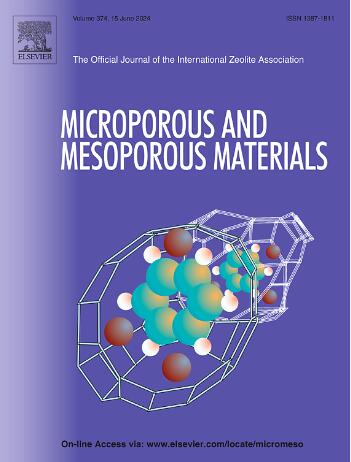Oxygen-promoted plasma-catalytic dry methane reforming over mesoporous catalysts for oxygenate production
IF 4.7
3区 材料科学
Q1 CHEMISTRY, APPLIED
引用次数: 0
Abstract
Plasma-catalytic dry methane reforming is an advanced approach for converting methane and carbon dioxide into syngas, hydrocarbons and liquid oxygenates, offering a sustainable pathway for greenhouse gas utilization. Plasma is used to trigger chemical reactions at relatively low temperatures, making it more energy-efficient and environmentally friendly compared to traditional high-temperature methods. In present work, a plasma-driven process of dry methane reforming was performed in dielectric barrier discharge reactor filled with mesoporous catalysts. The catalysts based on mesoporous materials MCM-41, SBA-15 and MCF were synthesized and characterized by the various physico-chemical methods. These catalysts were selected for their high surface area and tailored pore structure, which may assist in enhancing plasma-catalyst interactions, improving conversion efficiency, and promoting selectivity toward desired products. It was shown that Ni-based catalysts mainly promoted syngas and C2H6 formation, whereas Cu-based catalysts favored in liquid oxygenate yield enhancement. Cu-containing catalyst based on mesoporous MCF material has shown better CO2 conversion due to open wide mesopores. The oxygen addition to the CH4/CO2 mixture was studied. It was revealed that both gaseous products and oxygenate yields were enhanced in presence of O2. Methanol yield was increased due to parallel reactions of dry methane reforming and partial methane oxidation.

介孔催化剂上氧促进等离子体催化甲烷干重整制氧
等离子体催化甲烷干重整是一种将甲烷和二氧化碳转化为合成气、碳氢化合物和液态氧化合物的先进方法,为温室气体的可持续利用提供了一条途径。等离子体被用来在相对较低的温度下触发化学反应,与传统的高温方法相比,它更节能、更环保。在介孔催化剂介质阻挡放电反应器中,采用等离子体驱动甲烷干重整工艺。合成了基于介孔材料MCM-41、SBA-15和MCF的催化剂,并用各种物理化学方法对其进行了表征。这些催化剂因其高表面积和定制的孔结构而被选中,这可能有助于增强等离子体-催化剂的相互作用,提高转化效率,并促进对所需产物的选择性。结果表明,ni基催化剂主要促进合成气和C2H6的生成,而cu基催化剂则有利于液相氧产率的提高。基于介孔MCF材料的含铜催化剂由于介孔开阔,具有较好的CO2转化率。研究了CH4/CO2混合物中氧的添加。结果表明,在O2的存在下,气态产物和氧化产物的产率都得到了提高。通过干甲烷重整和部分甲烷氧化的平行反应,提高了甲醇收率。
本文章由计算机程序翻译,如有差异,请以英文原文为准。
求助全文
约1分钟内获得全文
求助全文
来源期刊

Microporous and Mesoporous Materials
化学-材料科学:综合
CiteScore
10.70
自引率
5.80%
发文量
649
审稿时长
26 days
期刊介绍:
Microporous and Mesoporous Materials covers novel and significant aspects of porous solids classified as either microporous (pore size up to 2 nm) or mesoporous (pore size 2 to 50 nm). The porosity should have a specific impact on the material properties or application. Typical examples are zeolites and zeolite-like materials, pillared materials, clathrasils and clathrates, carbon molecular sieves, ordered mesoporous materials, organic/inorganic porous hybrid materials, or porous metal oxides. Both natural and synthetic porous materials are within the scope of the journal.
Topics which are particularly of interest include:
All aspects of natural microporous and mesoporous solids
The synthesis of crystalline or amorphous porous materials
The physico-chemical characterization of microporous and mesoporous solids, especially spectroscopic and microscopic
The modification of microporous and mesoporous solids, for example by ion exchange or solid-state reactions
All topics related to diffusion of mobile species in the pores of microporous and mesoporous materials
Adsorption (and other separation techniques) using microporous or mesoporous adsorbents
Catalysis by microporous and mesoporous materials
Host/guest interactions
Theoretical chemistry and modelling of host/guest interactions
All topics related to the application of microporous and mesoporous materials in industrial catalysis, separation technology, environmental protection, electrochemistry, membranes, sensors, optical devices, etc.
 求助内容:
求助内容: 应助结果提醒方式:
应助结果提醒方式:


